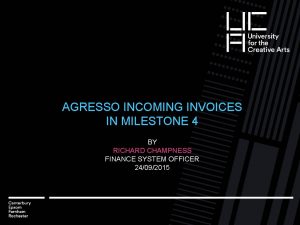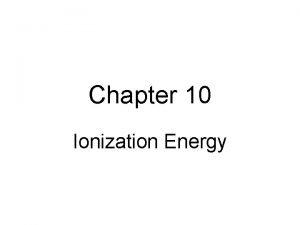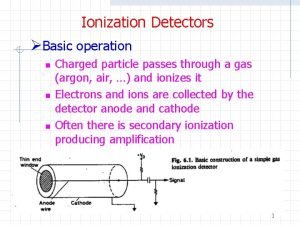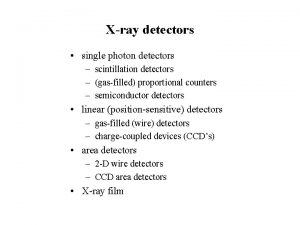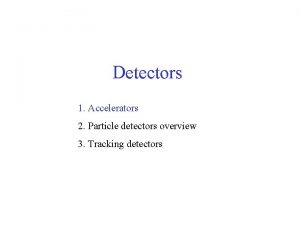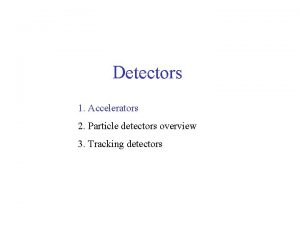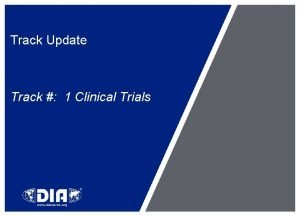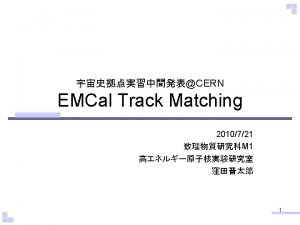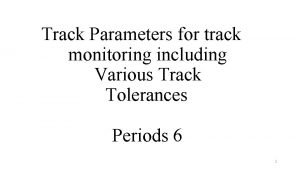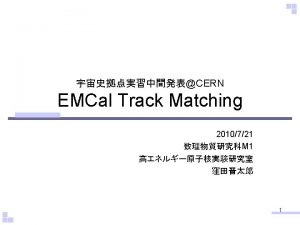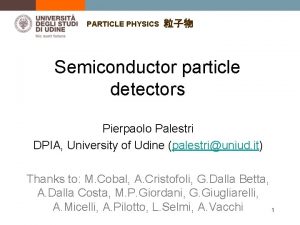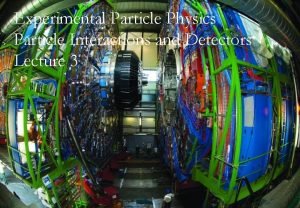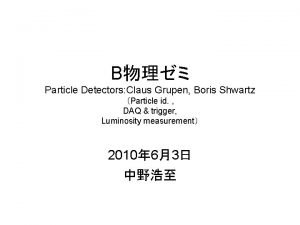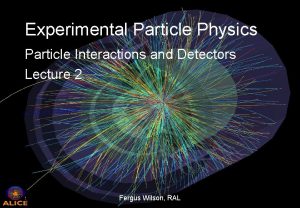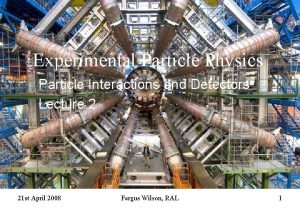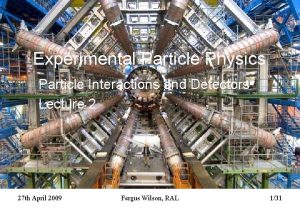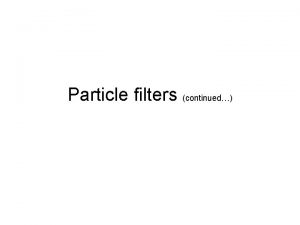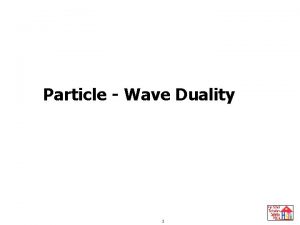Ionization detectors v incoming particle v ionization track






















- Slides: 22

Ionization detectors v incoming particle v ionization track ion/e- pairs Minimum-ionizing particles (Sauli. IEEE+NSS 2002) different counting gases: ionization process: Poisson statistics detection efficiency ε depends on average number <n> of ion pairs Indian Institute of Technology Ropar Hans-Jürgen Wollersheim - 2017

Effective ionization energies Large organic molecules have low-lying excited rotational states → excitation without ionization through collisions Indian Institute of Technology Ropar Hans-Jürgen Wollersheim - 2017

Charge transport in gas Electric field E = ΔU / Δx separates positive and negative charges E charge diffusion in electric field drift velocity mean time between collisions mobility There is a cycle of acceleration and scattering/ionization etc. drift(w) and diffusion (D) depend on field strength E and gas pressure ρ charge diffusion Indian Institute of Technology Ropar Hans-Jürgen Wollersheim - 2017

Ion mobility For ions there is an interplay between acceleration and collisions. Ion mobility is independent of field for a given gas at ρ, T = const. ions electrons He Ne Ar E/ρ (V/cm/torr) w+ ~ 10 -2 cm/μs w- ~ 101 cm/μs E. Mc. Daniel and E. Mason; The mobility and diffusion of ions in gases (Wiley 1973) Indian Institute of Technology Ropar Hans-Jürgen Wollersheim - 2017

Electron mobility In general, the mobility of electrons is not constant, but depend on on their kinetic energy and varies with the electric field strength. drift velocities of electrons in Argon-Methan mixtures drift velocities of electrons in different gases pure reduced electric field strength [V/cm mm Hg] Indian Institute of Technology Ropar Hans-Jürgen Wollersheim - 2017

Amplification counters single-wire gas counter v gas counters may be operated in different operation modes depending on the applied high voltage. Indian Institute of Technology Ropar Hans-Jürgen Wollersheim - 2017

Ionization chamber v An ionization chamber is operated at a voltage which allows full collection of charges, however below the threshold of secondary ionization (no amplification). planar ionization chamber For a typical field strength 500 V/cm and typical drift velocities the collection time for 10 cm drift is about 2 μs for e– and 2 ms for the ions. Time evolution of the signals for one e- ion pair: electrons ions Indian Institute of Technology Ropar total charge Hans-Jürgen Wollersheim - 2017

Signal collection v The motion of charges induces an apparent current in the electrodes. v Ion causes the same signal as the electron = same sign, same amplitude, but much slower Indian Institute of Technology Ropar Hans-Jürgen Wollersheim - 2017

Ionization chamber v v 252 Cf no gas gain charges move in electric field induced signal is generated during drift of charges induced current ends when charges reach electrodes source (25 k f/s) T 1/2=2. 645 y E = 6. 118 and 6. 076 Me. V binary fission/ -decay = 1/31 additional ´Frisch grid´: Ø electrons drift towards Frisch grid and induce a signal but not on the anode. Ø when electrons pass the Frisch grid, a signal is induced on anode. Ø the angular dependence of the electrons is removed from anode signal Indian Institute of Technology Ropar Hans-Jürgen Wollersheim - 2017

4π twin ionization chamber for fission fragments measured quantities: EH AH EL AL e- drift time ϑ segmented cathode Indian Institute of Technology Ropar φ Hans-Jürgen Wollersheim - 2017

Fission fragment mass measurement <108. 9 amu> <143. 1 amu> mass resolution σ = 3 amu P. Adrich, diploma thesis (2000) Indian Institute of Technology Ropar Hans-Jürgen Wollersheim - 2017

Determination of the polar angles angular resolution ϑ φ drift velocity: vdrift = 10 (cm/μs) 300 4. 20 range of fragments in methan gas: ℓ(E, A) 500 2. 50 distance cathode-anode: d = 3. 8 cm 700 2. 30 P. Adrich, diploma thesis (2000) Indian Institute of Technology Ropar Hans-Jürgen Wollersheim - 2017

Determination of the azimuthal angles energy ratios for different emission angles ϑ P. Adrich, diploma thesis (2000) Indian Institute of Technology Ropar Hans-Jürgen Wollersheim - 2017

Signal generation in ionization counters primary ionization in gases: I ≈ 20 -30 e. V/IP energy loss Δε: force: n = n. I = ne = Δε / I of primary ion pairs n at x 0, t 0 Fe = -e. U 0/d = -FI energy content of capacity C 1) 2) w+(t)∙(t-t 0) 1) + 2) total signal: electron & ion components Indian Institute of Technology Ropar Hans-Jürgen Wollersheim - 2017

Time-dependent signal shape total signal: electron & ion components drift velocities (w+ > 0, w- < 0) Both components measure Δε and depend on position of primary ion pair x 0 = w-∙(te-t 0) for fast counting use only electron component! Indian Institute of Technology Ropar Hans-Jürgen Wollersheim - 2017

Proportional counter gas amplification factor (typical 104– 106) is constant anode wire: small radius RA ≈ 50 μm or less voltage U 0 ≈ (300 -500) V field at r from the wire avalanche RI → RA, several mean free paths needed pulse height mainly due to positive ions (q+) Indian Institute of Technology Ropar Hans-Jürgen Wollersheim - 2017

Proportional counter cloud chamber The primary produced electrons drift the anode wire and reach the area of high electrical field strength. If a critical field strength is reached, a secondary ionization produces electrons in an avalanche. time sequence of the signal evolution primary ionization secondary ionization pos. ion Indian Institute of Technology Ropar pos. ions drift due to secondary ionization electron Hans-Jürgen Wollersheim - 2017

Proportional counter V 0 ~ 500 V p = 5 -10 Torr ~ 3 mm gap anode-cathode target entrance window ~ φlab ~ tanϑlab Δt ~ tanϑ Δtime → oi ii delay line Indian Institute of Technology Ropar Hans-Jürgen Wollersheim - 2017

Multi-Wire Proportional Chamber A multi-wire proportional chamber detects charged particles and gives positional information on their trajectory. Cathode plate d = 2 mm Wires Georges Charpak charge signals Nobel price 1992 Amplifier v time resolution: v position resolution: fast anode signals (trise ~ 0. 1 ns) for d = 2 mm σx = 50 -300 μm (weighted with charges) Indian Institute of Technology Ropar Hans-Jürgen Wollersheim - 2017

Multi-Wire Proportional Chamber Indian Institute of Technology Ropar Hans-Jürgen Wollersheim - 2017

Time Projection Chamber Ø Principle: Time Projection Chambers are based on the drift of the charge carriers with constant drift velocity v. D in a homogenous E-field (E = -d. U/dz). Ø typical parameters: E ~ 1 k. V/cm, v. D ~ 1 -4 cm/μs, Δz ~ 200 μm Ø 3 -dim. traces: z from the drift time, (x, y) from the segmented anode Indian Institute of Technology Ropar Hans-Jürgen Wollersheim - 2017

Geiger-Müller counter v The discharge is not any more localized v The number of charge carriers is not any more related to the primary ionization v The gas amplification amounts to 108 -1010 Indian Institute of Technology Ropar Hans-Jürgen Wollersheim - 2017
 Streaming potential
Streaming potential Where are feature detectors located
Where are feature detectors located Chromatography mobile phase and stationary phase
Chromatography mobile phase and stationary phase Frontier detectors for frontier physics
Frontier detectors for frontier physics Vhv voltage detectors
Vhv voltage detectors Feature detectors ap psychology
Feature detectors ap psychology Giant wave detectors murmurs universe
Giant wave detectors murmurs universe Yodsawalai chodpathumwan
Yodsawalai chodpathumwan Photo detectors
Photo detectors Feature vectors
Feature vectors Giant gravitational detectors hear murmurs across
Giant gravitational detectors hear murmurs across What is thermal detector
What is thermal detector Nuclear detectors
Nuclear detectors Feature detectors
Feature detectors Incoming mail register book
Incoming mail register book Mikrotik radius incoming
Mikrotik radius incoming Incoming sales
Incoming sales Incoming sensory impulses and outgoing motor impulses
Incoming sensory impulses and outgoing motor impulses Incoming telephone calls
Incoming telephone calls The neuron process that normally receive incoming stimuli
The neuron process that normally receive incoming stimuli Telephone techniques chapter 14
Telephone techniques chapter 14 Agresso accounts payable
Agresso accounts payable Unit 1 dealing with incoming calls
Unit 1 dealing with incoming calls





















